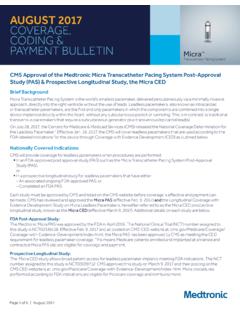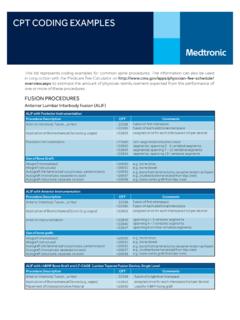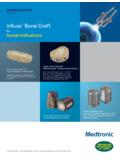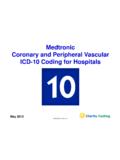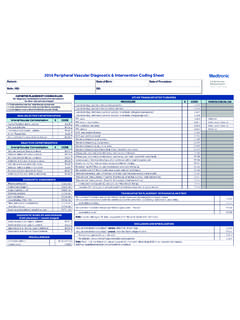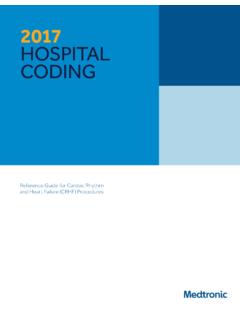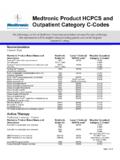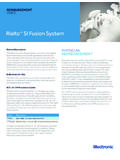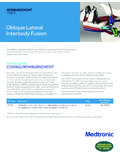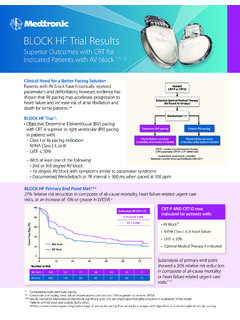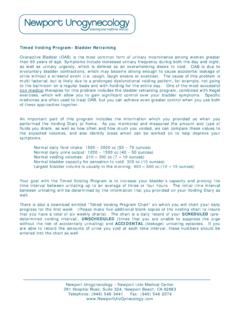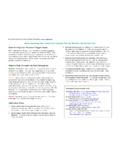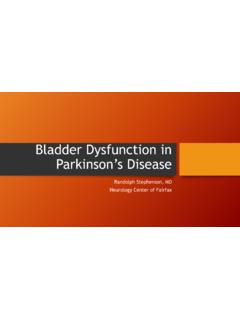Transcription of For Continence Management - Medtronic
1 ITable of ContentsUrinary and Bowel IncontinenceACT Program for Continence ManagementNursing Care PlansBowel And bladder RetrainingEducational MaterialF315 and MDS ComplianceInteractiveACT Program For Continence ManagementAssessment and Continence Training2 Table of ContentsUrinary and Bowel IncontinenceACT Program for Continence ManagementNursing Care PlansBowel And bladder RetrainingEducational MaterialF315 and MDS ComplianceTable of ContentsContents1. INTRODUCTION ..32. Urinary and Bowel is urinary incontinence? ..5 Function of the Urinary System ..5 Identifying Incontinence ..6 Summary of the Types and Causes of Urinary Incontinence ..7 What is bowel incontinence? ..8 Anatomy of the Digestive System ..9 Function of the Digestive System ..103. Assessment and Continence Training (ACT) Program ..11 What Steps Should I Take? ..12 Step 1: 1: 2: Diagnosis ..13 Step 3: Planning ..13 Step 4: Implementation ..14 Step 5: Evaluation.
2 144. Bowel and bladder Retraining Implementation ..15 Bowel and bladder Retraining Goals ..16 Starting a Bowel and bladder Retraining Program ..17 Behavioral Treatments ..181. Prompted Voiding ..192. Scheduled Voiding ..193. Pelvic Muscle Exercises ..20 Bowel Retraining Techniques ..205. F315 and MDS Compliance ..21F315 Compliance Checklist ..23 MDS and Incontinence ..256. EDUCATIONAL MATERIAL ..26 Skin Care ..26 Resident Teaching Instructions ..27 Pharmaceutical Management of Incontinence ..28 Drugs Affecting Incontinence ..28 Additional Resources ..297. Forms and Nursing Plans ..303 Table of ContentsUrinary and Bowel IncontinenceACT Program for Continence ManagementNursing Care PlansBowel And bladder RetrainingEducational MaterialF315 and MDS ComplianceAs a concerned caregiver, you know the challenges incontinence can present both for your resident s quality of life and for you as a medical professional working to improve physical and mental health.
3 Incontinence is not a normal part of aging and is a symptom, not a disease. In many cases, it can be program is designed to take you through a process that will help you assess the specific needs of each incontinent resident and design a care plan to meet the physical and psychosocial challenges presented. This can be done in a manner consistent with the overall goal of your healthcare facility and the F315 guidelines as outlined by the Centers for Medicare & Medicaid Services (CMS). The goal of the program is to help each incontinent resident achieve their highest level of Continence . The Assessment and Continence Training (ACT) Program is one tool to assist you in reaching the goals of your healthcare facility as well as to aid you in achieving compliance with the F315 and MDS guidelines. Please note that this tool may be used in conjunction with other tools available to achieve those goals. The practices described in this program are meant to be general guidelines only.
4 Caregivers should consult with and rely on trained practitioners and their own facility s protocols to determine proper care and treatment regimens for their to use the ACT a facility team member to manage the with a Covidien Nurse Consultant for the Bowel and bladder Daily Diary to deter mine the resident s voiding and bowel pattern uponadmission and with any significant change in the Physical Assessment form to determinethe type of incontinence upon admission and with anysignificant change in appropriate plan of care for appropriate incontinence product for usebased on level of a Nursing Care resident s program and re evaluate Flow Sheets, Evaluation Forms, and Resident Logs to document resident progress or make necessary modifi cations to the bowel/ bladder retraining program10. Educate resident and family about program goals andprogressINTRODUCTIONT able of ContentsUrinary and Bowel IncontinenceACT Program for Continence ManagementNursing Care PlansBowel And bladder RetrainingEducational MaterialF315 and MDS Compliance4 Urinary and Bowel IncontinenceIncontinence is defined as the inability to control the release of urine or stool.
5 5 Table of ContentsUrinary and Bowel IncontinenceACT Program for Continence ManagementNursing Care PlansBowel And bladder RetrainingEducational MaterialF315 and MDS ComplianceUrinary IncontinenceWhat is urinary incontinence?Urinary incontinence is defined as the inability to control the release of urine at the appropriate time or place. Incontinent episodes can range from infrequent, involuntary discharge of large volumes of body waste to constant or intermittent dribbling of small amounts of incontinence is not considered a normal part of aging. It is a symptom of an underlying condition and may be reversible. If it is found to be irreversible, it is important to manage the incontinence to reduce potential affects the resident at three levels: Physical effects of incontinence: Changes in skin integrity Skin irritation or breakdown Urinary tract infections Sleep disturbances Psychosocial effects of incontinence: Social withdrawal Embarrassment Loss of dignity Feelings of isolation Interference with participation in activities Economical effects of incontinence: Cost of testing to diagnose incontinence Treatment cost (drugs or surgery) Management cost (labor, supplies, laundry)Most elderly residents who are incontinent do have some degree of bladder control, either consciously or uncon sciously.
6 Their chronic incontinence is mainly due to abnormalities in the function of the bladder detrusor muscle ( bladder wall) and/or the sphincter muscles (outlet). For this reason, it is important to understand the function of the lower urinary of the Urinary SystemFunction of the Urinary System1 There are four main structures in the urinary system: the kidneys, the ureters, the bladder and the urethra. The function of the urinary system is to remove waste from the body. The urinary system also regulates the amount of water in the body. Voiding, urination and micturition are terms that refer to the process of emptying the output volume of urine depends on f luid intake, cardiac output, hormonal inf luences and f luid loss through the lungs, skin and the large bowel. The approximate urine output of the healthy adult is between 1000 mL and 1500 mL per day with an average void measuring between 200 mL and 400 mL. In an adult, the first sensation of bladder filling normally occurs at a volume of 90 mL to 150 mL.
7 The sensation of fullness occurs at a volume of 300 mL to 600 mL. The amount of urine produced is also inf luenced by body temperature, perspiration, and the external temperature. The kidneys function more efficiently when people lie down and are at rest, causing them to make more urine. Because of this, older adults may need to use the bathroom one or more times at night. The frequency of urination also depends on personal habits, the amount of f luid consumed in a given period of time, accessibility of toilet facilities, general health and level of physical muscles of the pelvic f loor form what is known as the urogenital diaphragm. They are attached to the pubic bone and ischium; they encircle and help support the urethra, vagina and of ContentsUrinary and Bowel IncontinenceACT Program for Continence ManagementNursing Care PlansBowel And bladder RetrainingEducational MaterialF315 and MDS ComplianceVoluntary contraction of these muscles results in compression, lengthening and elevation of the urethra.
8 Voiding can be interrupted by contracting the pubococcygeal muscle. The deep perineal muscles of the urogenital diaphragm are attached to the pubic arch superiorly and surround the membranous urethra as the external muscle sphincter, a structure important to normal cycle of micturition begins when the bladder receives urine from the kidneys through the ureters. As the bladder slowly fills with urine, the pressure inside the bladder remains low. When the detrusor muscle reaches a certain threshold of distention, sensory nerve endings in the bladder wall are stimulated to transmit the sensation of fullness to the spinal cord through the pelvic nerve. Other nerves then transmit this message to the brain. The brain then sends a message back down the spinal cord and out through the peripheral nerves to initiate voiding (at the appropriate time and place). This sequence of events is known as the micturi tion ref lex. This is also known as the brain bladder connec tion which is important for the success of a bladder retraining IncontinenceAlthough urinary incontinence is not considered part of the normal aging process, age related changes are predisposing factors and do make incontinence more likely in older people.
9 For example, the elderly may have more uninhib ited bladder contractions and urine leakage at night. The bladder size is smaller so the rate of f low is decreased. The restriction of toilet accessibility along with changes in sight, hearing, balance and ambulation also increase the vulner ability of incontinence for the frail (Environmental) IncontinenceSome residents may have total control over their bladder function but, due to outside influences, they cannot reach or use a toilet. This condition is referred to as functional, or environmental, incontinence. Physical inability or unwillingness to reach the toilet on time, poor vision, lack of mobility, inaccessible facilities and unfamiliar surroundings are some of the factors affecting functional IncontinenceStress incontinence occurs when the sphincter is insufficient. When the resident coughs, sneezes, lifts, stands from a sitting position, climbs stairs, laughs, etc.
10 , the urethral pressure is not high enough to keep urine in the bladder . As a result, small leakage of urine occurs. Stress incontinence may be due to deterioration in muscle tone caused by aging, multiple childbirths or surgery that weakens the muscles of the pelvic IncontinenceUrge incontinence involves involuntary voiding preceded by a warning time of only a few seconds to a few minutes. The resident is unable to delay voiding long enough to reach the toilet after the urge to void is perceived. Urge incontinence is the most common type found in the elderly population. Causes may include: Hyperexcitability of the detrusor nerves (detrusor instability)caused by infection in the bladder , tumors or kidney stones Defect in the central nervous system s (CNS) regulation ofurination resulting from Alzheimer s disease or CNS disease Deconditioned reflexes caused when a person repeatedly startsto urinate when there is only a small amount of urine in thebladder; thus, the bladder muscle gets weakerTransient IncontinenceResidents who have temporary episodes of urinary inconti-nence that is reversible once the underlying cause of the incontinent episode ( urinary tract infection) is identified and treated.
